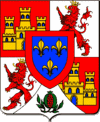Asunción
| |||||
| Motto: Semper Fidelis (Latin: Always Faithful) | |||||
| Official languages | Spanish, French (in most areas) | ||||
| Anthem | {{{Anthem}}} | ||||
| Capital | Ávila | ||||
| Largest city | Las Cruces | ||||
| Archduke of Asunción | Archduke Augusto | ||||
| Premier | Archduke Augusto (No party affiliation) | ||||
Asunción was formerly a province of the Empire of the Alexandrians. It is located in the western half of the San Martino Isle, north of Cibola. It was merged with the province of Puerto Nuevo, to its east to form the province of San Martin.
Important cities
- Las Cruces, 210,000
- Ávila, 198,177 (capital of the province)
- Rosalinda (Santa Maria de Rosalinda), 87,654
Government
The Alexandrian Constitution of 2005 allows every Alexandrian province to form its own provincial government. Asunción was the second and last province of the Empire to create its own provincial government. Asunción is ruled by a Governmental Council, headed by the Archduke of the province. The Archduke of Asunción serves as the viceroy, or representative of the Emperor, in provincial affairs.
The Governmental Council of Asunción serves as the executive, legislative and judicial branches of the provincial government. It is composed by four members – the Archduke, the MP from the province and two other members elected by the residents of the province.
The provincial Constitution is the Carta Magna of Asunción. It is the only constitution of its kind in the Empire.
The province is currently represented in the Imperial Parliament by Cardinal Jacques de Beaufort, from the Alexandrian Conservative Party.
History
Fictional History
For history of Asunción prior to becoming an Alexandrian province, see Kingdom of Asunción.
The Kingdom of Asunción joined the Kingdom of Alexandria in December of 1187 with the death of King Francisco II of Asunción. At the time, Alexandria was being ruled by the House of Carvajal, which was also the ruling house of Asunción. The House of Carvajal was linked to the House of Alexandria-Sardinia through the marriage of Queen Maria of Asunción (1108-1149) and Prince Francois of Alexandria, 3rd brother of Joseph I in the year 1109.
After the death of Joseph I in 1114 AD, the Alexandrian throne was passed to his son Robert I The Pious (1114-1126). He died childless, and thus, the throne was passed to his uncle, who became Justinian II (1126-1141). Justinian II died of leprosy in 1141 and his youngest son became Phillip I (1141-1159). His elder brothers had all died of either leprosy or tuberculosis, which was seen as a curse upon the Royal Family at the time (See the Alexandria-Sardinia curse). Phillip I was known as a “merry king”, according to the chroniclers of the time. He often consumed much alcohol and had many illicit affairs with women of the court. It was also rumored that he was homosexual. One night in August of 1159, coming to the Palace of Geneva after parties thrown in honor of his friend (and rumored lover) the Duke of Geneva, he died of a very high fever brought on by excessively consuming alcohol. He died childless.
Queen Isabel of Asunción (1149-1170) was poised to become the first Queen of Alexandria, but law barred her from taking the Alexandrian throne, leaving her brother Prince Louis of Asunción as the heir. He became Louis I (1159-1172), the first of the Carvajal dynasty. In 1170, Queen Isabel of Asunción died and her son became King Francisco II of Asunción. Louis I followed his sister to the grave in 1172.
During the reign of Louis III (1185-1205), grandson of Louis I, King Francisco II of Asunción died childless after five different marriages failed to produce an heir. In the will, Louis III was made heir and inherited Asunción. In 1189, the Kingdom of Asunción was officially made a province of Alexandria.
Fictional History of Alexandria is currently being written. Please keep checking the history articles for more updates as the history is published.
Micronational History
The province of Asunción was officially formed by the Golden Triangle Reforms of 2005. The old Martino sections of Las Cruces, parts of Los Santos and Altamira were merged to create it.
Soon after its creation, the province took up a reputation for being by far the most conservative province in the Empire. It also took up a reputation for being the Catholic heartland of the Empire - it was in this province that parties like the Catholic Monarchist Party of Sofia de Aragon and the Cardinal's Way Party of Cardinal Jacques de Beaufort started. Soon after the collapse of the religious right movement, the people of Asunción turned to the Alexandrian Conservative Party.
Economy
Asunción is primarily known as the center of Alexandrian agriculture. However, it is also home to a thriving tourist industry. The province is a heavy producer of sunflower seeds, lemons, soybeans, grapes, corn, tobacco, peanuts, tea, and wheat.
Its industrial outputs are food processing, tourism and construction. Las Cruces also serves as a center for the insurance industry in Alexandria.
| Political divisions of the Empire of the Alexandrians | |||||
|---|---|---|---|---|---|
| |||||

